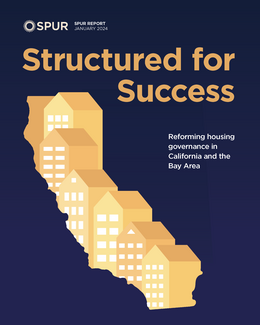California’s high housing costs are the direct result of the state’s failure to build enough housing. And yet one of the central causes of this failure — a decentralized and fragmented housing governance system — has received neither the attention it needs, nor the reform it demands.
Multiple state and regional agencies, offices, departments, and systems are responsible for planning and funding housing. There are two misaligned regional planning processes, and the state agencies that fund affordable housing are run by two separate officials. Add hundreds of cities, each with its own authority to zone for housing, and the complexity of housing governance in the Golden State becomes dizzying.
SPUR’s new report Structured for Success explains how California’s current housing governance system works, details the challenges of the existing system, and offers recommendations to improve it so that California can produce a sufficient amount of housing.
SPUR’s recommendations stem from one central insight: Despite the fact that zoning and planning are local actions, the only way to move California forward is through state-level reform. The Bay Area cannot solve its governance problems on its own. The report puts forward 11 recommendations at the state, regional, and local levels that could set California and the Bay Area on the path to produce the housing we need.
